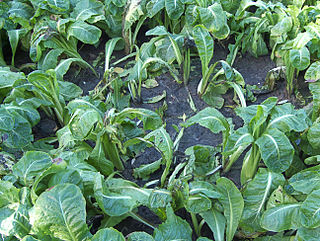 W
WAster yellows is a chronic, systemic plant disease caused by several bacteria called phytoplasma. The aster yellows phytoplasma (AYP) affects 300 species in 38 families of broad-leaf herbaceous plants, primarily in the aster family, as well as important cereal crops such as wheat and barley. Symptoms are variable and can include phyllody, virescence, chlorosis, stunting, and sterility of flowers. The aster leafhopper vector, Macrosteles quadrilineatus, moves the aster yellows phytoplasma from plant to plant. Its economic burden is primarily felt in the carrot crop industry, as well as the nursery industry. No cure is known for plants infected with aster yellows. Infected plants should be removed immediately to limit the continued spread of the phytoplasma to other susceptible plants. However, in agricultural settings such as carrot fields, some application of chemical insecticides has proven to minimize the rate of infection by killing the vector.
 W
WCandidatus Phytoplasma fraxini is a species of phytoplasma, a specialized group of bacteria which lack a cell wall and attack the phloem of plants. This phytoplasma causes the diseases ash yellows and lilac witches' broom.
 W
WElsinoë ampelina is a plant pathogen, which is the causal agent of anthracnose on grape.
 W
WHosta virus X (HVX) is a virus that infects Hostas. The disease was first identified in 1996 by plant pathologists at the University of Minnesota, and grouped with the Potato X (potex) viruses. The virus has reached epidemic proportions and can be found in most garden centers and nurseries around the globe.
 W
WPhytophthora cactorum is a plant pathogen that causes root rot on rhododendron and many other species.
 W
WPodosphaera macularis is a plant pathogen infecting several hosts including chamomile, caneberrie, strawberries, hop, hemp and Cineraria. It causes powdery mildew of hops.
 W
WThis article is a list of diseases of poinsettia.
 W
WPseudomonas cichorii is a Gram-negative soil bacterium that is pathogenic to plants. It has a wide host range, and can have an important economical impact on lettuce, celery and chrysanthemum crops. P. cichorii was first isolated on endives, from which it derives its name. It produces 6-aminopenicillanic acid. Based on 16S rRNA analysis, P. cichorii has been placed in the P. syringae group.
 W
WPseudomonas marginalis is a soil bacterium that can cause soft rots of plant tissues. It infects poinsettia, lettuce, and crucifers.
 W
W'Pseudomonas tomato' is a Gram-negative plant pathogenic bacterium that infects a variety of plants. It was once considered a pathovar of Pseudomonas syringae, but following DNA-relatedness studies, it was recognized as a separate species and several other former P. syringae pathovars were incorporated into it. Since no official name has yet been given, it is referred to by the epithet 'Pseudomonas tomato' .
 W
WPuccinia malvacearum, also known as hollyhock or mallow rust, is a species within the genus Puccinia known for attacking members of the family Malvaceae. An autoecious pathogen, it can complete its life cycle using a single host.
 W
WPuccinia pelargonii-zonalis is a plant pathogen that causes rust on Pelargonium geraniums.
 W
WPuccinia thaliae is the causal agent of canna rust, a fungal disease of Canna. Symptoms include yellow to tan spots on the plant's leaves and stems. Initial disease symptoms will result in scattered sori, eventually covering the entirety of the leaf with coalescing pustulates. Both leaf surfaces, although more predominant on the underside (abaxial) of the leaf, will show yellow to brownish spore-producing these pustulate structures, and these are the signs of the disease. Spots on the upper leaf-surface coalesce and turn to brown-to-black as the disease progresses. Infection spots will become necrotic with time, with small holes developing in older leaves. These infected leaves eventually become dry and prematurely fall.
 W
WPucciniastrum epilobii is a plant pathogen infecting fuchsias.
 W
WPycnostysanus azaleae or Seifertia azaleae is an ascomycete fungus that is a plant pathogen infecting azaleas and rhododendrons.
 W
WRhodococcus fascians is a Gram positive bacterial phytopathogen that causes leafy gall disease. R. fascians is the only phytopathogenic member of the genus Rhodococcus; its host range includes both dicotyledonous and monocotyledonous hosts. Because it commonly afflicts tobacco (Nicotiana) plants, it is an agriculturally significant pathogen.
 W
WSchizothyrium pomi is a plant pathogen of the sooty blotch and flyspeck complex, infecting apple, pear and citrus trees and carnations.
 W
WTheliaviopsis basicola is the plant-pathogen fungus responsible for black root rot disease. This particular disease has a large host range, affecting woody ornamentals, herbaceous ornamentals, agronomic crops, and even vegetable crops. Examples of susceptible hosts include petunia, pansy, poinsettia, tobacco, cotton, carrot, lettuce, tomato, and others. Symptoms of this disease resemble nutrient deficiency but are truly a result of the decaying root systems of plants. Common symptoms include chlorotic lower foliage, yellowing of plant, stunting or wilting, and black lesions along the roots. The lesions along the roots may appear red at first, getting darker and turning black as the disease progresses. Black root lesions that begin in the middle of a root can also spread further along the roots in either direction. Due to the nature of the pathogen, the disease can easily be identified by the black lesions along the roots, especially when compared to healthy roots. The black lesions that appear along the roots are a result of the formation of chlamydospores, resting spores of the fungus that contribute to its pathogenicity. The chlamydospores are a dark brown-black color and cause the "discoloration" of the roots when they are produced in large amounts.
 W
WVerticillium albo-atrum is a plant pathogen with many hosts.